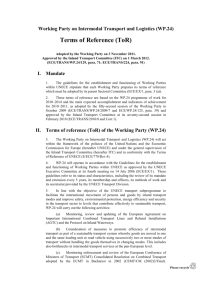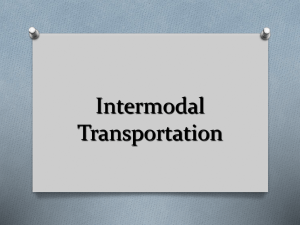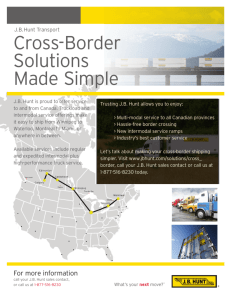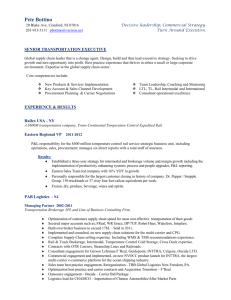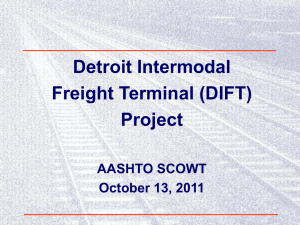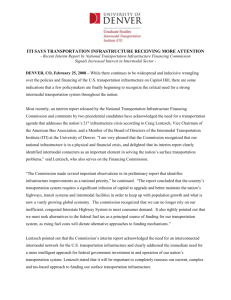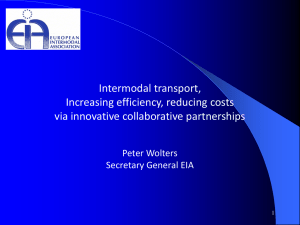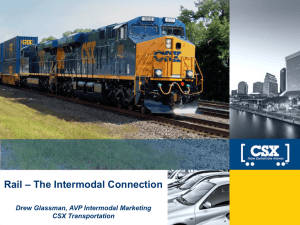fiata
advertisement
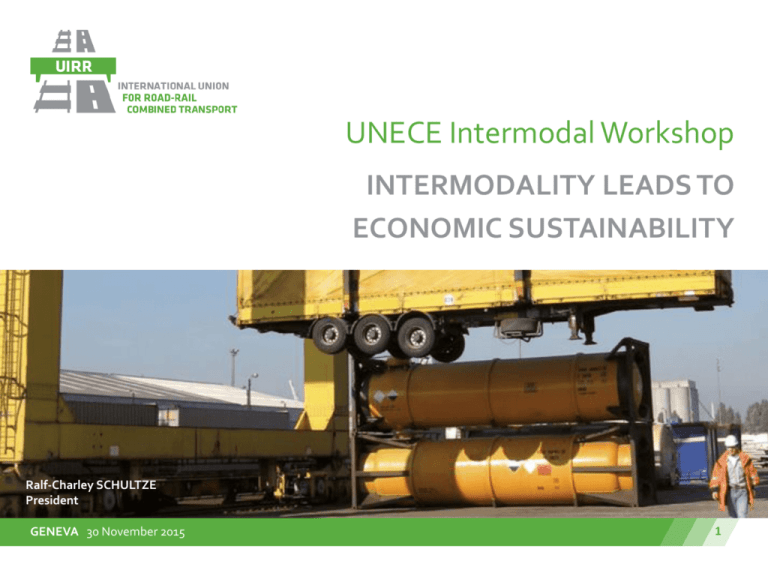
UNECE Intermodal Workshop INTERMODALITY LEADS TO ECONOMIC SUSTAINABILITY Ralf-Charley SCHULTZE President GENEVA 30 November 2015 1 UIRR - Overview 2 Members: Combined Transport Operators and Terminal Managers, who enable the efficient insertion of rail into transport-chains Logistics companies, road hauliers: customers as well as shareholders of UIRR Members Performance: UIRR Members handled about 50% of European Combined Transport in 2014 Interest: fair regulatory conditions in transport to enable competition on the basis of technical merit and competence/management excellence UIRR: founded in 1970 - seat in Brussels since 1988 UNECE Intermodal Workshop | 30 November 2015 UIRR - Strategy UIRR is an industry association which - PROMOTES the public understanding and appreciation of Road-Rail Combined Transport, - ENHANCES its development and the proliferation of industry best practice, - SUPPORTS the daily operation of European Combined Transport with a series of services UNECE Intermodal Workshop | 30 November 2015 3 UIRR - Mission Grow the pie through fair competition on the basis of 1) technical merit, as an enabler of economic prosperity 2) the competence (professionalism) of those who organise CT catalysed by UIRR as the industry association of the sector UNECE Intermodal Workshop | 30 November 2015 4 UIRR – Growth rate of Members 1989 – 2014 UNECE Intermodal Workshop | 30 November 2015 5 Mission letter of the new Transport Commissioner 6 ”…the reduction of greenhouse gas emissions by the transport sector contributes to the achievement of the overall EU target in this area. This should be part of our overall effort to reinforce the sustainability of our growth model.” UNECE Intermodal Workshop | 30 November 2015 EU 2011 Transport White Paper 7 Shift 30% of long(er) distance road tonne-kilometres realised over distances of 300km or more by 2030 from trucks to sustainable modes of transport - (electric) rail, inland navigation and shortsea shipping - which ratio should increase to 50% by 2050* * on the basis of 2010 UNECE Intermodal Workshop | 30 November 2015 The challenge at hand The Beauty… (?) 8 and The Beast Intermodal/Combined Transport in Europe UNECE Intermodal Workshop | 30 November 2015 The key to intermodality: switch to using the ”box” 9 Containerisation: the pre-requisite to unlock the benefits Combined Transport HIGH VALUE PERISHABLES OVERSIZED LIQUIDS DANGEROUS GOODS BULK PALLETS UNECE Intermodal Workshop | 30 November 2015 Unimodal vs. Intermodal transport 10 UNIMODAL FREIGHT TRANSPORT Misses out on advantages: - energy efficiency, - labour productivity, - superior safety and security, - climate resilience, and - oustanding environmental peformance. INTERMODAL / COMBINED TRANSPORT Efficiently inserts economically and ecologically sustainable modes of transport into long(er) distance transport-chains to maximise the benefits for every stakeholder. UNECE Intermodal Workshop | 30 November 2015 Primary energy need and CO2 performance of modes UNECE Intermodal Workshop | 30 November 2015 11 Safety performance comparison Safety category Fatalities in 20091 Accident occurrences: (i) road1 and (ii) rail2 Accident occurrences: (i) HGVs, (ii) freight trains Accident externality cost of (i) HGVs on motorways, and (ii) trains 1 Source: 12 Road Rail 35 000 34 1 200 000 Road haulage is 30-times as accident prone as rail 31 per 100M vkm2 1,05 per 100M vkm3 €68 667 per 100M tkm4 €238 per 100M tkm5 EC EU transport in figures [2011] at 2nd IRU/EU Road Transport Conference: “31 per 100M vkm” [2012] 3 Source: ERA 2011 Rail Safety report figure (tkm) converted to (HGV) vkm @ 30t/vehicle rate [2011] 4 Source: CE Delft IMPACT Study (internalisation handbook) converted into tkm @ 30t/vehicle rate [2008] 5 Source: CE Delft IMPACT Study (internalisation handbook) converted into tkm @ 800t/train rate [2008] 2 Source: Alan C McKinnon UNECE Intermodal Workshop | 30 November 2015 1152 External costs of modes 13 External costs of rail: 33% of road Ro-Ro and smaller vessels perform worse UNECE Intermodal Workshop | 30 November 2015 Distance-based eTolling on all roads UNECE Intermodal Workshop | 30 November 2015 14 The relative competitive situation of modes 15 Two principles should be equally upheld: - user-pays - polluter-pays “Subsidies” to rail freight: (i) Track access charges: - based on distance travelled on the entire network (ii) Internalised externalities: - renewable energy surcharge - infrastructure scarcity surcharge - railway noise Subsidies to trucks: (i) Inadequate road tolls - No tolling: 6 Member States - Time-based: 12 Member States - Distance-based: 10 Member States charging a limited network only. (ii) Non-internalised externalities - air- and noise-pollution, accidents, congestion, land-rent, oil-dependency Limited internalisation of CO2 emissions and climate-change UNECE Intermodal Workshop | 30 November 2015 The de-politicisation of transport - no more budget transfers would be needed to make transport truly market based and competitive in a fair manner. Competitiveness of the railway sector 16 THE SOLUTION The Fourth Railway Package: fair intramodal competition, homogeneous infrastructure management, technical harmonisation and reduced administrative burden Rail Freight Corridor Regulation: seamless cross border travel, coordinated development and maintenance works, capacity planning and traffic management The new TEN-T Guidelines and the Connecting Europe Facility: interoperable and homogeneous infrastructure, removal of capacity bottlenecks Standardisation: CEN, ERA, UN ECE, OTIF, UIC, voluntary industry best practice recommendations Implementing Acts and reporting: Commission guidance and enforcement of implementation concerning the European rules; as well as statistics collection and reporting Traction Train path Quality on rail Infrastructure UNECE Intermodal Workshop | 30 November 2015 Wagons The Regulators’ Challenge 17 Relative competitive framework - user to pay all costs: involved with accessing the public transport infrastructure; in case of roads it is land rent, operation (cleaning, rescue – emergency services, policing/traffic management), maintenance and construction Internalisation - congestion: value charging principle – congestion surcharge within road toll (scarcity surcharge) - local pollution: noise, PM10, vibration, landscape destruction – within road toll - accidents: loss to society due to loss of life or permanent injury – insurance surcharge - GHG emission and oil dependency: climate change and ”wars for oil” – fuel excise duty Within the railway sector - end privileged relationships: traction service and other railway transportation providers should be allowed to fairly compete – irrespective of ownership / grouping with infrastructure manager - rail infrastructure investments to be subject to strict cost-benefit-analysis: be based on business rationality – not only subject to political preference (vote maximisation) For the intermodal sector - harmonised regulatory framework throughout the EU: eliminate heterogeneity present in prevailing Member State level regulatory framework to help create a genuine single market UNECE Intermodal Workshop | 30 November 2015 Regulatory framework for Combined Transport 1/2 18 The recast of Directive 92/106 to create a genuine single market in the EU Framework legislation - definitions and Pan-European rules for technical aspects such as codification, certification, registration, etc. Temporary benefits - to counterbalance the regulatory disadvantage for as long as it continues to prevail (proportionately to the status quo in each Member State) Optimised infrastructure - complementing the large CEF Transport projects with small scale development aid on a Member State level to eliminate infrastructure limitations faced by consignors if wishing to shift to intermodal/combined transport continued… UNECE Intermodal Workshop | 30 November 2015 Regulatory framework for Combined Transport 2/2 19 The recast of Directive 92/106 to create a genuine single market in the EU Development plans - encouraging the complex horizontal thinking required by intermodal/combined transport based logistics on a Member State level Intermodality test - systematic test of any policy or regulatory proposal as part of the impact assessment to check whether an intermodal/combined transport solution could not deliver the desired outcome more efficiently Monitoring and reporting - accurate measurement of intermodal/combined transport performance and regular feed-back to the decision-makers UNECE Intermodal Workshop | 30 November 2015 Modal split without SSS (coastal shipping) 20 = Source: TRANSFORuM Project Report on Long Distance Freight, June 2015 UNECE Intermodal Workshop | 30 November 2015 ”Achievable, even if challenging” Source: TRANSFORuM Project Report on Long Distance Freight, June 2015 UNECE Intermodal Workshop | 30 November 2015 21 The preference should be clear 22 CO2 emissions Road degradation Energy efficiency The answer: Labour productivity Intermodal solutions Congestion Accidents: injuries and fatalities UNECE Intermodal Workshop | 30 November 2015 PM10 emissions Oil dependency A Challenge to Logistics Professionals 23 Unimodal solution Intermodality trucks trucks Terminals road logistics centres intermodal terminals Long-haul road-only (megatrucks) rail, SSS, IWW not necessary prerequisite business as usual creative, innovative thinking Short-haul (positioning/distribution traffic) Containerisation (using intermodal loading units) Consignors, logistics service providers INTERMODALITY = CREATIVE, INNOVATIVE THINKING IN TRANSPORT UNECE Intermodal Workshop | 30 November 2015 The outlook 24 THE RELATIVELY LOW SHARE OF RAIL FREIGHT IN EUROPE PROMISES A CONSIDERABLE UPSIDE POTENTIAL FOR GROWTH UNECE Intermodal Workshop | 30 November 2015 The future: Combined Transport can do the job …if and where the framework conditions are right Competition and transparency: level playing-field for the different modes Recognition of freight: train path capacity allocation Development of capacities: lines and terminals (infrastructure) Quality and accountability Transalpine traffic through Switzerland 1984 – 2010 UNECE Intermodal Workshop | 30 November 2015 25 THANK YOU For your attention 26
